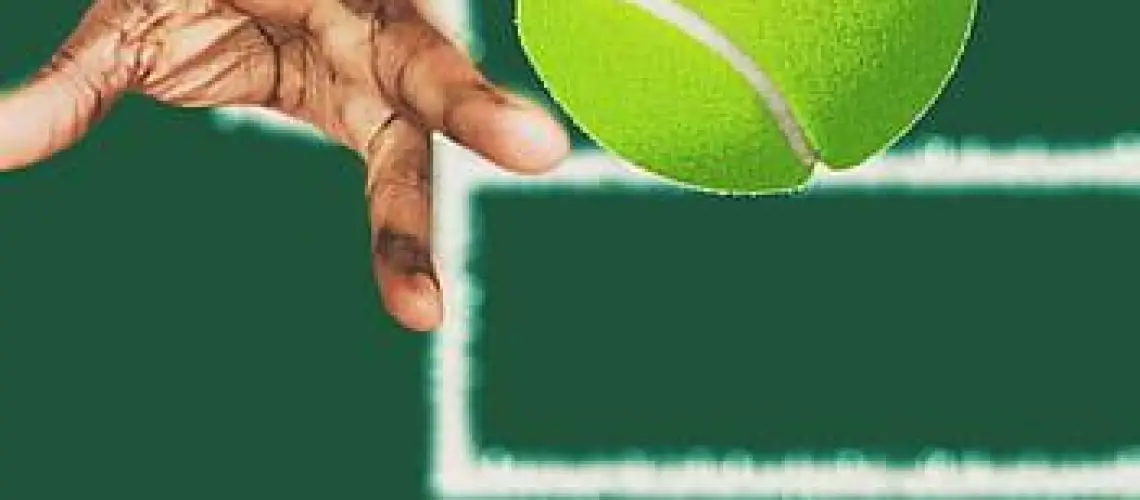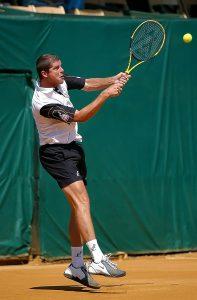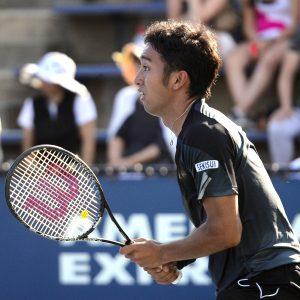We may earn money or products from the companies mentioned in this post.
Introduction

Have you ever wondered why some tennis players have a powerful and accurate serve, while others struggle to find consistency? The secret lies in their serving stance A correct serving stance not only helps generate power and accuracy but also minimizes the risk of injury In this blog post, we will delve into the importance of having the right serving stance in tennis and provide you with valuable insights to improve your game
Basic Serving Stance Techniques

When it comes to serving in sports like tennis or volleyball, having the right stance can make all the difference in your performance In this article, we will explore two basic serving stances: the platform stance and the pinpoint stance Each of these stances offers unique benefits and requires specific execution for optimal results
Platform Stance
The platform stance is a widely used technique that provides stability and control during serves By adopting this stance, players can generate power while maintaining balance on the court
-
Description and Benefits:
The platform stance involves positioning your feet shoulder-width apart with both toes pointing towards the net This creates a solid base, allowing for better weight distribution and stability throughout the serve The primary benefit of this stance is its ability to provide consistent and accurate serves -
How to execute it correctly:
a) Foot Positioning:
To execute the platform stance correctly, position your feet approximately shoulder-width apart, parallel to each other This ensures a stable foundation for your serve
b) Weight Distribution:
Distribute your weight evenly between both feet, keeping it centered for maximum balance during the serve motion
c) Body Alignment:
Align your body perpendicular to the net, facing your target Keep your knees slightly bent and maintain an upright posture throughout the serve
Pinpoint Stance
The pinpoint stance is another popular serving technique that offers increased power potential by utilizing a more explosive motion
-
Description and Benefits:
The pinpoint stance involves positioning one foot slightly in front of the other, with the majority of your weight on your back foot This stance allows for a greater range of motion and generates more power during the serve -
How to execute it correctly:
a) Foot Positioning:
To execute the pinpoint stance correctly, position one foot slightly in front of the other, with the toes of your back foot pointing towards the net The distance between your feet may vary depending on personal preference
b) Weight Distribution:
In this stance, most of your body weight should be on your back foot This allows you to transfer power from your lower body to generate a stronger serve
c) Body Alignment:
Similar to the platform stance, align your body perpendicular to the net, facing your target Maintain an upright posture with slight knee bend and prepare for an explosive serve
By understanding and practicing these basic serving stances – platform and pinpoint – athletes can improve their serving technique, accuracy, and power on the court Remember that consistency and practice are key elements in mastering any sports skill
Finding the Ideal Position on the Court for Your Serve

When it comes to serving in tennis, finding the ideal position on the court is crucial Understanding court dimensions and lines is essential to make strategic choices Let’s take a closer look at these elements:
Understanding court dimensions and lines when serving
- The center service line divides the court into two equal halves, creating symmetry
- The service box is where you must aim your serve to start the point
- The baseline marks the farthest boundary of the court
By familiarizing yourself with these lines, you can determine your optimal starting point for each serve type
Choosing your position based on serve type
Depending on whether you’re hitting a flat serve, slice serve, or kick serve, your positioning on the court will vary Let’s explore each one:
-
Flat serve positioning:
For a powerful flat serve that aims to go straight and fast, positioning yourself slightly behind and towards the center of the baseline can give you better control and reach -
Slice serve positioning:
When executing a slice serve that curves away from your opponent, standing further towards one side of the baseline can help create an angle that makes it more challenging for them to return effectively -
Kick serve positioning:
To execute a kick serve that has plenty of topspin and bounces high upon landing in your opponent’s service box, standing closer towards one side of the baseline allows you to generate more spin by hitting around and under the ball
Remember, finding the right position on the court for your serve can make a significant difference in your game By understanding the court dimensions and lines and adjusting your positioning based on the type of serve you want to execute, you’ll increase your chances of gaining an advantage over your opponent
Advanced Tips for Maximizing Serve Effectiveness and Consistency

When it comes to serving in tennis, finding your individual style and preference in serving stance can make a significant difference in your overall performance It’s crucial to experiment with different positions within the legal boundaries to discover what works best for you By analyzing your strengths and weaknesses, you can identify an optimal stance that allows you to maximize the power, accuracy, and consistency of your serves
To enhance your serve effectiveness and consistency, it’s essential to practice consistency in footwork, body movements, and ball toss placement Developing a consistent routine will help ensure that all the elements of your serve come together seamlessly Pay attention to your footwork, maintaining proper balance throughout the motion Coordinate your body movements smoothly, from the preparation phase to the follow-through Additionally, work on placing your ball toss consistently so that you can hit it at its ideal contact point every time
A great way to improve your own serving technique is by watching professional players’ styles for inspiration Take note of Roger Federer’s platform stance – a balanced position with both feet firmly on the ground before initiating the serve This technique allows for excellent stability and control during execution Another player to observe is Novak Djokovic, known for his pinpoint stance where one foot is slightly ahead of the other when starting the serve This technique helps generate extra power while maintaining accuracy
The importance of understanding where to stand when serving in tennis

When it comes to serving in tennis, one crucial aspect that often goes overlooked is the positioning on the court Where you stand can significantly impact your ability to execute a powerful and accurate serve It’s not just about hitting the ball over the net; it’s about strategically placing yourself for maximum advantage
Optimizing power and accuracy
The position from which you serve can greatly influence your ability to generate power and hit accurate shots By standing in the right spot, you can maximize your swing motion and effectively transfer energy into the ball This allows you to deliver faster serves with greater control, making it harder for your opponent to return
Imagine standing too far back on the court during your serve Your shot might lack power as you struggle to generate enough force by stretching out your arm fully On the other hand, taking a position too close to the net might lead to inaccuracies, causing frequent faults or easy opportunities for your opponent
Gaining tactical advantages
The positioning on the court also plays a crucial role in gaining tactical advantages over your opponent Tennis is a game of strategy, and where you stand when serving can potentially give you an upper hand
For instance, if you take a wider stance towards one side of the court, it creates an angle that makes it more challenging for your opponent to return with precision This strategic placement forces them into uncomfortable positions and increases their chances of making errors
Similarly, by adjusting your position closer towards either sideline or centerline, you can strategically exploit weaknesses in your opponent’s game If they have trouble returning serves directed at their backhand side or struggle with wide shots, adjusting your stance accordingly can give you an edge
Adapting to different opponents
Understanding where to stand when serving is not a one-size-fits-all approach It requires adaptability and the ability to assess your opponent’s strengths and weaknesses
If you’re playing against an opponent with a powerful return, standing deeper on the court can give you more time to react and adjust On the other hand, if your opponent struggles with fast serves, moving closer to the net can add pressure and limit their options
By being aware of your opponent’s tendencies and adjusting your stance accordingly, you can exploit their weaknesses while capitalizing on your own strengths
In conclusion,

The importance of understanding where to stand when serving in tennis cannot be overstated By optimizing power and accuracy, gaining tactical advantages, and adapting to different opponents, you can elevate your serving game to new heights So next time you step onto the court, don’t just focus on hitting that perfect serve; consider where you stand for maximum impact
Useful Links

The Perfect Tennis Serve in 8 Simple Steps
How to Serve in Tennis: 6-Step Guide
How to Serve a Tennis Ball (with Pictures)
Tennis Return of Serve – Ultimate Tennis Guide
Serve – which stand should you use?
Rules of Tennis | Wanless Park Tennis
Tennis Serving Rules And Receiving Rules in few steps!
Tennis Serve Technique – Seven Steps to Correct Serve
USTA (Official) – Is a receiver allowed to stand ANYWHERE …
Rules of the Tennis Serve: An Exhaustive Guide
Tennis Serve Stance: Pinpoint or Platform Stance?
1.2 – Tennis Serve Stance and Setup
Where to stand in doubles – Position is key advises strategy …
11 Steps To Hit A Perfect Tennis Serve
5 Tennis Serve Tips for Better Technique & More Power
Where Do You Serve In Table Tennis? – The Racket Life
Tennis Serving Rules 101
A 6 Step Guide to the Tennis Return of Serve
Scores and Serving Side – Tennis






